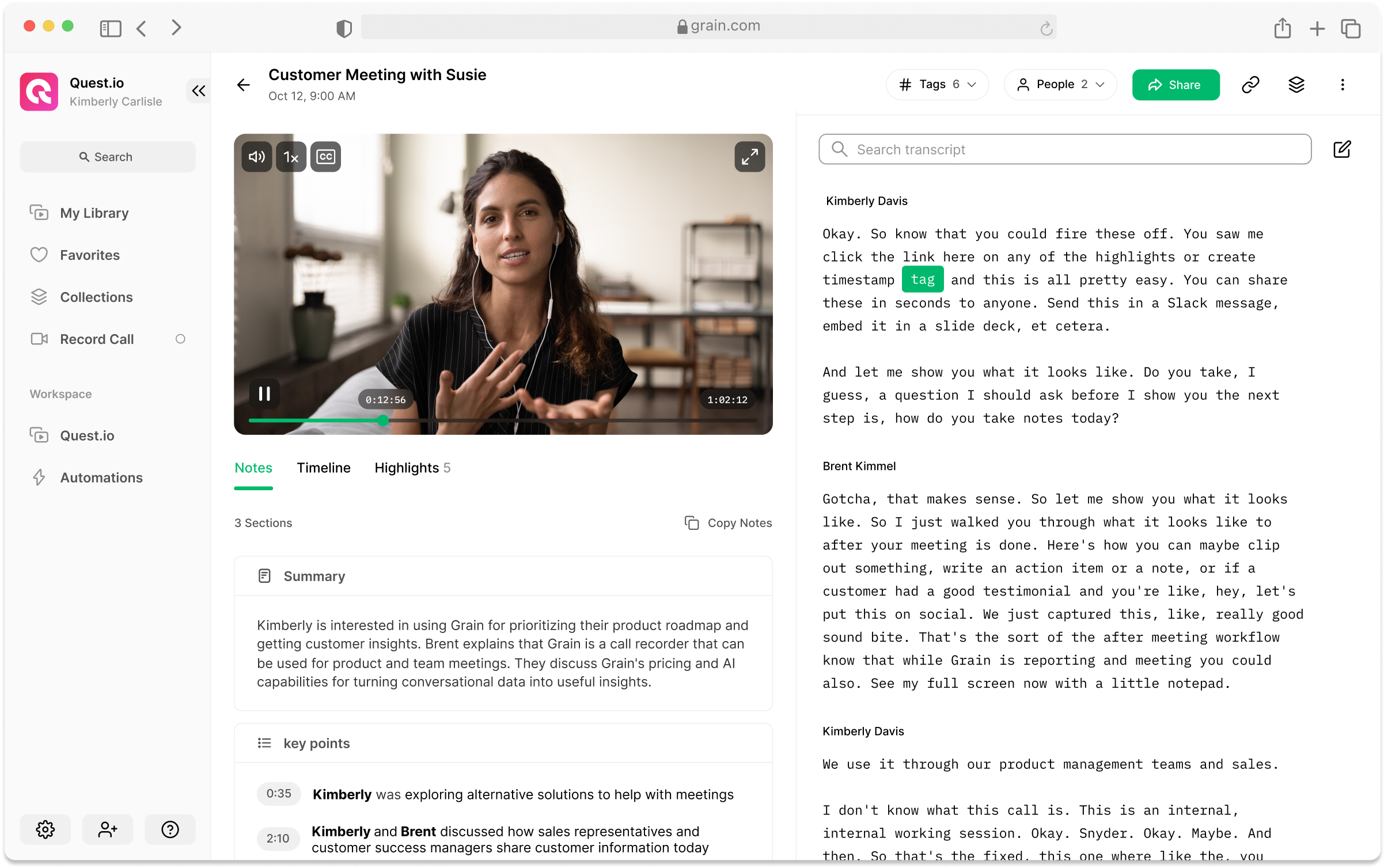Run a Successful Quarterly Business Review
Many customer success managers worry about running quarterly business reviews (QBRs) with their clients in fear that they won't fully meet the customer's needs or that they'll fall short in some way. That's especially true if it's been a minute since your last catch-up and you're unsure about how satisfied your customers are.
But it doesn’t have to be that way. With some planning and preparation, you can run a successful QBR with your customers that not only satisfies their needs but also drives business results. Let’s get started.
What is a QBR?
Short for "Quarterly Business Review", a QBR is a meeting with your customer that occurs on a regular basis, typically every 3-4 months. During a QBR, you review the impact your product has had on their business, discuss any major goals or challenges they're facing, and plan for the future of your collaboration.
“QBRs are a time to strengthen your partnerships, highlight the ROI, and reinforce the value to your customer. In my opinion, it's the best time to flex your 'customer first' muscle and ensure their needs are met and they're achieving their goals with your product”
- Katie Stamey, Customer Success Manager, Grain.
Why You Should Hold Quarterly Business Reviews
Here are the top benefits of holding QBRs with your customers:
Demonstrate Your Commitment to Clients
Regular touchpoints like QBRs help you cultivate strong relationships with your customers, demonstrating that you're committed to helping them succeed. They add a personalization element to your customer's experience, reassuring them that they're more than just a number in your pipeline.
Plus, having a face to put on your product can go a long way in building trust and loyalty.
Gain Insights Into Client Trends and Needs
Often, by speaking to multiple customers, you'll start to notice common trends or common pain points. This gives you valuable insight into what's working and not working for your customers, allowing you to make product improvements or changes that better align with their needs.
For instance, if your SaaS product has been experiencing issues with customer onboarding, you might learn that many customers struggle to set up a new account or configure their profile. Armed with this knowledge, your product team can work on streamlining the onboarding process to reduce friction and help more customers activate quickly.
“Sometimes, It's hard to think outside of the box because you are so ingrained in your product. But a user can come in with fresh opinions and can help you understand what could be better.”
- Katie Stamey, Customer Success Manager.
Generate New Sales Opportunities
In addition to a better understanding of customer needs and pain points, QBRs can also help you spot new sales opportunities. That might be a contract renewal or the chance to upsell them on new features or services.
For instance, if you offer a premium level of service that includes additional support, you might notice that some customers are struggling with a specific technical issue or having difficulty getting up to speed on your product. This could be an opportunity to identify those customers and offer them your premium package to ensure they get the most out of your product.
Identify At-Risk Accounts
Were you ever surprised when a customer suddenly stopped using your product or canceled their subscription? You probably chalked it up to them having a change of heart, but sometimes there are more complex reasons behind their decision.
Clients don't just decide one day to leave your product—they'll show warning signs well in advance. By regularly conducting QBRs, you can identify and address these red flags before they lead to churn.
Showcase ROI and Success
When customers use your product for a long time, they often get used to their daily operations running smoothly. While your product has been making things easier for them, they might not see how much value it's bringing to the business.
This is where a QBR comes in. During your review, highlight key metrics and case studies demonstrating how your product is delivering results for the company as a whole. This will help your customer better understand how much your product contributes to their bottom line, which can be crucial in winning additional budgets or securing renewal contracts.
“You can also capture and share testimonials from your previous customer check-ins.”
Plan for the Future Together
Finally, QBRs aren't just about what has happened in the past. They're also a great platform for planning for the future. During these meetings, you can discuss updates to your product roadmap and how those changes might impact your customer's business.
By working together, you'll be able to identify new opportunities and ensure that all parties are aligned on goals moving forward.
What’s Included in a QBR?
That may have sounded like a lot of ground to cover in a single quarterly business review. However, it isn't. Here's exactly what a QBR should include:
Product Usage Review
During this portion of the QBR, you'll review how your customers use your product. This may include things like usage metrics, breadth of usage, customer feedback, and any challenges or issues that have arisen.
ROI & Benchmarking Presentation
This is where you'll want to quantify the value that your product brings to the customer and showcase any relevant case studies or success stories. You might also want to compare your customer's usage and spending to industry benchmarks, as well as track their performance over time with those benchmarks.
By presenting this information clearly and concisely, you can help your customer see the full picture of how they're benefiting from your product.
Renewals and Upsells Discussion
After you've paved the way for renewal and upsell opportunities through the ROI & benchmarking presentation, this is where you'll want to attempt to close these deals. This could include discussing contract renewals, upsells to premium packages and services, or any other strategies that will help secure the future of your relationship.
Upcoming Product Roadmap Preview
Before you end the QBR, discussing any planned updates to your product roadmap is a good idea. This can help your customer better understand how you're addressing their needs and what new features or enhancements are coming down the pipeline.
Keeping your customers in the loop will make them feel more confident in your product and your company as a whole.
Action Items From the QBR
Lastly, be sure to cover any action items that need to be addressed following the QBR. This could include setting up additional meetings or calls, reviewing key metrics regularly, or taking other steps to support your customer moving forward.
By outlining all of these important tasks at the end of your review, you'll help ensure that everyone is on the same page and ready to take the next steps toward achieving your shared goals.
Mistakes to Avoid When Running a QBR
To make the most out of your quarterly business review, steer clear of these common pitfalls:
Not Defining the Outcome
When planning your QBR, it's important to have clear goals and understand what you're hoping to achieve. This could be anything from upgrading customers to your premium package or securing a renewal contract, so make sure you're clear on what success looks like before the meeting starts.
Avoid treating the QBR as a one-and-done event that you just want to get out of the way. Instead, think of it as an opportunity to build a stronger relationship with your customers and help them see the full value that your product can provide.
Not Preparing a Detailed Agenda
If you don't come to the QBR with a clear agenda, you'll find it over before it's even started. You'll drift off course, waste time on topics that aren't relevant, and ultimately leave both parties feeling frustrated.
To avoid this issue, prepare a detailed QBR agenda that outlines exactly what topics you'll be covering and how much time you'd like to spend on each one. That way, you'll be able to keep things on track and stay focused the entire time.
Turning the Meeting Into a Sales Pitch
While you do want to discuss any upcoming renewals or upsell opportunities, this should be more of a natural progression from the rest of your QBR. If you start trying to sell your customers on additional services immediately, they'll lose interest and start tuning out.
Instead, focus on building trust and showing how your product can benefit them. Let the conversation flow naturally, present benefits and ROI clearly and concisely, and you'll find that customers are much more likely to buy your product.
If you do it right, you'll have minimal selling to do by the end of the QBR, and you'll have a lot more success when it comes time to close the deal.
Not Listening to the Customer
This standard pitfall applies to any customer-facing meeting, but it's especially important to keep in mind during the QBR. Your customers are there to share their thoughts and concerns, so it's critical that you actively listen and engage with them.
Today there are plenty of tools that can make sure you don't miss a thing without you having to take manual notes and one such tool is Grain.
Grain automatically records, transcribes, and summarizes your QBR meetings with AI so that you can review the content later on. With Grain, you'll be able to give your customers the focus and attention they deserve.

“It [Grain recording] allows me to focus on the calls, focus on the customers, and focus on what they need”
- Steeve Vakeeswaran, Head of Sales and Expansion at Zapier.
In addition, Grain allows you to clip and share key moments from your meetings with your product/engineering teams. This will ensure that your QBRs are translated into real, tangible improvements to your product.
Not Having a Strategy for Dealing With Challenges
Finally, it's important to be prepared for any challenges that come up during the QBR. Whether it's a customer who isn't satisfied with your product or simply a discussion that gets heated, having a strategy in place will help you stay calm and focused on addressing the issue at hand.
Don't wait until this happens during the meeting itself; instead, think about how you'll handle these situations proactively.
For instance, one strategy that many CSMs use is to have a trial run with a devil's advocate. Having a QBR with someone who challenges your data and asks tough questions helps you identify potential problems—ahead of the actual QBR meeting. This means, you won't be blindsided during your QBR and you'll be better equipped to handle any challenges that may come up.
Quarterly Business Review Examples
If you want to make your QBRs as effective as possible, consider using a Quarterly Business Review template to help guide the meeting. These templates can include sample agendas, detailed outlines of topics you'll cover, and other resources that will ensure that you stay on track throughout the meeting. Here are 2 samples.
QBR Meeting Template 1:

QBR Meeting Template 2:

Conclusion
When utilized to their full potential, quarterly business reviews can be invaluable for building better relationships and driving more sales with your customers. By following these tips, you'll be able to run successful QBRs every time—without the frustration and stress that many CSMs experience.
Put these tips into action, and you're sure to see a difference in your upcoming QBR meetings. With the right preparation and tools such as Grain to help capture user insights, you can take your customer relationships to the next level and start seeing real results for your business. Good luck with your next QBR!



.png)



